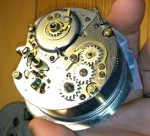
First four of the La Salle series alarm clocks by Westclox, case by Dura.
At an antique fair in Folsom, CA, I happened across a hexagonal shape metal alarm clock that really intrigued me. What really caught my eye was the design. I knew it was old and probably from the 1920’s, but I knew little else. I plunked down my $20, an eyebrow raiser to my friends and family, and took the little mass of metal home. Eventually I got the little clock to run and that started a mild alarm clock collecting interest. I have gone on to acquire more of the cast aluminum alarm clocks by Westclox known as the Dura clocks. [Click images below to enlarge]

401 Model 61 C Dura Westclox
As the Great Depression started to creep across the country in 1930, Westclox introduced their La Salle line of

Art Deco Chrysler Building
alarm clocks. Westclox teamed up with the Dura Manufacturing Company in Todedo, Ohio, to create the La Salle series of clocks inspired by the popular Art Deco design style that had become so widespread in the 1920’s.
The Dura Manufacturing Company designed and made various objects of plastic and cast aluminum. George Graff was the Dura designer who is attributed with designing at least six of the “Dura” cases. Two of the designs, model 402 and 403 were chosen to be displayed in the Third International Industrial Exhibition.1 The Dura cases were mated with the Baby Ben movement to create the La Salle series of alarm clocks.
Aluminum is considered a relatively young metal having only been discovered in 1761. Unlike other metals that can be found in their elemental form or easily extracted with chemicals or heat, aluminum can only be extracted on a large scale with the use of an electrolytic process. This requires passing a substantial electrical current through an aqueous solution to precipitate the aluminum. With the advent of easily generated electrical currents in the 1880’s, aluminum started to be produce for commercial purposes.
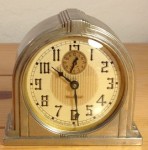
402 Model 61 D Dura Westclox
Aluminum has a relatively low melting point (1220o F vs. Copper 1983o F), light weight, structurally strong
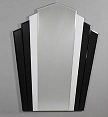
Art Deco mirror
and easily machined. It makes a great metal for casting objects that can be buffed to a mirror like finish, just perfect for some of the styles of the Art Deco age. (I remember casting aluminum stick shift knobs in high school metal shop) The downside is that develops a thin layer of oxide fairly quickly which dulls the finish. Consequently, companies like Dura applied nickel plating to the die cast aluminum to prevent oxidation. For the La Salle line of alarm clocks it was called a “Butler” finish which gave the appearance of pewter.
Over time the finish on the the Dura clocks will show little bubbles of oxidation under the finish or small pits. Without the low luster of the Butler finish, the clock can look somewhat unfinished. But that doesn’t detract from the designs which are timeless. The models I have 61 -C,-D, -F and -G were all manufactured between 1930 and 1934. Records I have seen indicate that the 61-G started production in 1931. The 61-G has less line detail but it has a dial with numbers more representative of the art deco style. The back also has an art deco stylized W for Westclox and a more finish design look to it.
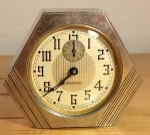
403 Model 61 F Dura Westclox
Weighing over a pound each, when you bought one of these clocks you felt like you were really purchasing a

Baby Ben movement in the La Salle series alarm clocks by Westclox.
piece of equipment. But after all, it was the machine age and these clocks certainly resembled the new machines and construction of the era. I am not sure how much one the clocks would have cost originally. I know you could buy a relatively inexpensive alarm clock for under a dollar back then.
Westclox Ben movements were known for quality and durability. The La Salle series used the Baby Ben movement which was a scaled down version of the Big Ben movement. Both of them were designed and built to last. I have successfully reconditioned several Westclox movements and they keep good time. The only real challenge I have encounter is a pressed on brass cannon bushing that cracks. The crack creates a rough spot on the main arbor which causes a hiccup in the time keeping.
I don’t need them to keep time. Just sitting on a shelf is enjoyment enough for me. This is especially true when I realized that these little clocks gave years of excellent service to the original owners. Day in and day out these little clocks would ring in the beginning of a new day. Now I just let them quietly tick away while I watch the hands move.
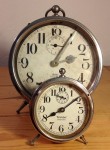
The original Big and Baby Bens by Westclox.
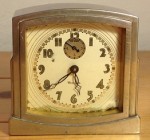
404 Model 61 G Dura Westclox
1. Westclox Wind Up, by Jim Linz, Schiffer Publishing Ltd., 4880 Lower Valley Road, Atglen, PA 19310

